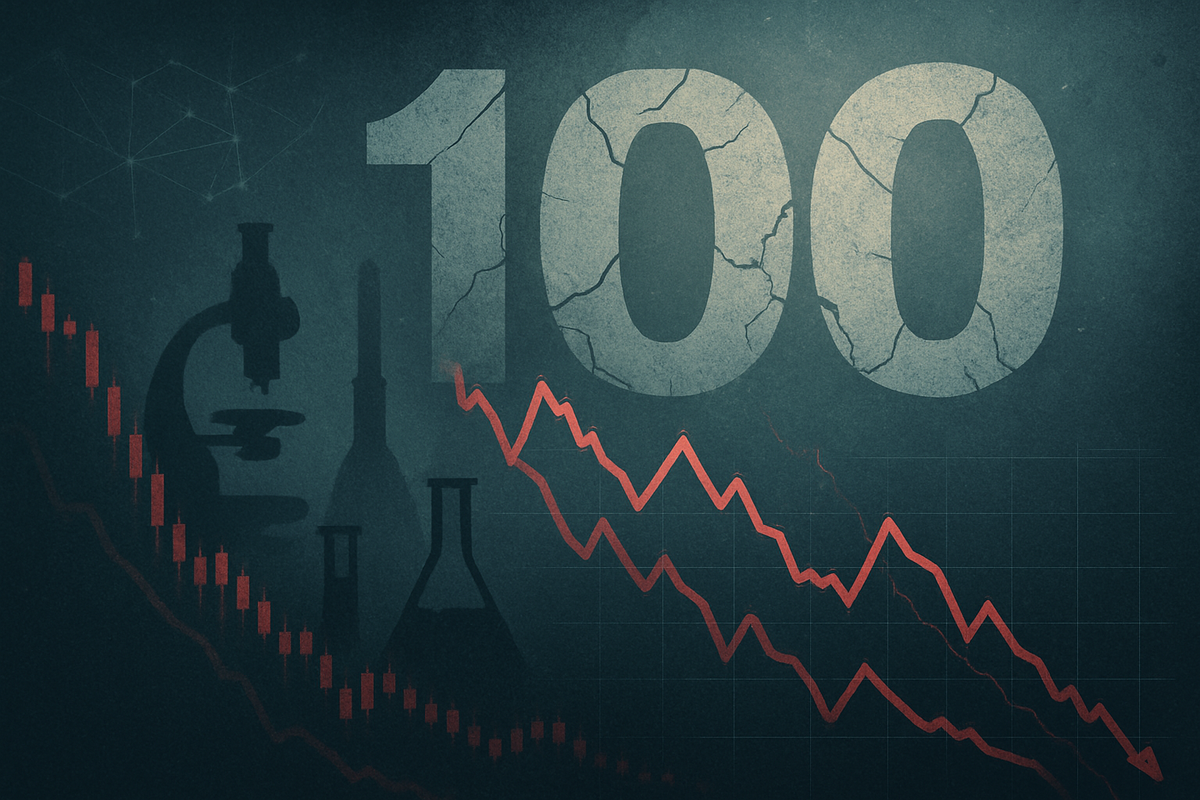
October 17, 2025 – In the volatile world of biotechnology, ambitious price targets often fuel investor speculation and market buzz. However, for Turnstone Biologics Corp. (NASDAQ: TSTN), the notion of its stock reaching a $100 valuation stands in stark contrast to its current precarious financial and operational state. Despite the transformative potential of innovative funding mechanisms like blockchain-backed investments in the broader biotech landscape, Turnstone Biologics finds itself navigating a dramatically different trajectory, marked by a recent acquisition at a fraction of a dollar per share, the discontinuation of its lead clinical program, and significant corporate restructuring. This article delves into the current realities facing Turnstone Biologics, examining why a $100 price target is currently unattainable and what this signifies for the company and the wider market.
The inquiry into whether Turnstone Biologics Corp. could hit a $100 price target emerges at a critical juncture for the company. As of mid-October 2025, the company's stock is trading around $0.355, reflecting a precipitous decline of over 96% in the past three to five years. This valuation is directly tied to a definitive merger agreement announced on June 27, 2025, where Turnstone Biologics agreed to be acquired by XOMA Royalty Corporation (NASDAQ: XOMA) for $0.34 in cash per share, plus a non-transferable contingent value right (CVR). This acquisition, anticipated to close in August 2025, effectively caps the immediate upside for existing shareholders at a value far removed from any triple-digit aspirations. The immediate implication is clear: the company's future as an independent, publicly traded entity with significant growth potential is effectively over, making a $100 price target a speculative fantasy rather than a market possibility.
A Timeline of Decline: From Clinical Promise to Corporate Acquisition
The journey leading to Turnstone Biologics' current predicament has been marked by a series of challenging developments. In February 2025, the company made the difficult decision to discontinue all clinical studies for its last remaining clinical-stage candidate, TIDAL-01. This move was attributed to the capital-intensive manufacturing requirements of the program and the prevailing unfavorable financial market conditions, which made continued development unsustainable. This discontinuation represented a significant setback, as TIDAL-01 was central to the company's therapeutic pipeline, focused on Selected Tumor-Infiltrating Lymphocyte (TIL) therapy for solid tumors.
Prior to this, in October 2024, Turnstone Biologics had already embarked on a strategic restructuring plan, which included an approximately 60% reduction in its workforce. At that time, the company aimed to prioritize TIDAL-01's development and extend its cash runway into the second quarter of 2026. However, the subsequent decision to halt TIDAL-01's clinical program in February 2025 superseded these earlier plans, leading to further redundancies and an active exploration of strategic alternatives to maximize shareholder value. This exploration culminated in the announced acquisition by XOMA Royalty Corporation, signaling the end of Turnstone Biologics' independent operational phase. The tender offer for the acquisition was expected to commence by July 11, 2025, with the merger closing shortly thereafter in August, meaning by October 2025, the company is either fully integrated or in the final stages of this transition.
While the concept of blockchain-backed investments has garnered attention for its potential to revolutionize biotech funding and operations, there is no indication that Turnstone Biologics Corp. (NASDAQ: TSTN) engaged in such innovative financing models. The company's strategic focus, particularly in its later stages, was on traditional pathways for capital and strategic alternatives, ultimately leading to an acquisition rather than a pivot towards decentralized finance.
Ripple Effects: Winners, Losers, and the Shifting Biotech Landscape
The acquisition of Turnstone Biologics (NASDAQ: TSTN) by XOMA Royalty Corporation (NASDAQ: XOMA) at a distressed valuation has several implications for stakeholders in the biotech market. The most apparent "losers" are the existing shareholders of Turnstone Biologics who have witnessed a near-complete erosion of their investment, culminating in an exit at $0.34 per share plus a CVR, a stark contrast to any hopeful $100 target. Employees affected by the multiple rounds of layoffs also bear a significant cost.
On the other hand, XOMA Royalty Corporation (NASDAQ: XOMA) stands to potentially "win" by acquiring Turnstone's remaining assets, intellectual property, or any residual value at a significantly reduced price. XOMA specializes in acquiring royalty interests and milestone payments, and this acquisition might be a strategic move to consolidate valuable assets or intellectual property that could generate future revenue streams if successfully repurposed or out-licensed. Competitors in the TIL therapy space, such as Iovance Biotherapeutics (NASDAQ: IOVA) or other companies developing advanced oncology treatments, might see Turnstone's exit as a consolidation of the market, potentially reducing competitive pressure. However, it also highlights the inherent risks and high capital requirements associated with developing complex immunotherapies, serving as a cautionary tale for the industry. The event underscores the challenging environment for clinical-stage biotechs, especially those with capital-intensive programs facing market headwinds.
Broader Significance: A Cautionary Tale in Biotech Innovation
Turnstone Biologics' trajectory serves as a poignant example of the inherent risks and formidable challenges within the biotechnology sector, especially for companies reliant on single-asset pipelines and significant capital injections. This event fits into a broader industry trend where promising early-stage science often struggles to translate into commercial success due to escalating R&D costs, stringent regulatory hurdles, and intense competition. The discontinuation of TIDAL-01, a TIL therapy, highlights the specific difficulties in advancing cell-based immunotherapies, which often entail complex manufacturing processes and high development costs.
The regulatory implications, while not directly tied to Turnstone's current situation, underscore the critical role of regulatory approvals in biotech valuations. The failure to progress TIDAL-01 through clinical trials meant it never reached the stage where regulatory bodies like the FDA would be the primary determinant of its market viability. For the broader industry, Turnstone's fate might lead to increased scrutiny from investors regarding the financial viability and scalability of capital-intensive therapeutic platforms. Historically, similar events have often led to consolidation within specific therapeutic areas, as larger, more financially robust pharmaceutical companies acquire distressed smaller firms for their innovative assets or technology platforms. This could catalyze further M&A activity in the oncology and cell therapy spaces, as larger players seek to mitigate risk by diversifying their portfolios or by acquiring technologies at a discount.
What Comes Next: Navigating a Post-Acquisition Landscape
In the short term, the primary focus will be on the complete integration of Turnstone Biologics into XOMA Royalty Corporation (NASDAQ: XOMA). This involves the orderly transfer of any remaining intellectual property, assets, and possibly specific personnel relevant to XOMA's royalty business. For the former shareholders of Turnstone, the contingent value right (CVR) represents the only remaining potential for additional value, contingent upon specific future events or milestones that would need to be met. The market will be watching for any announcements from XOMA regarding how they plan to leverage the acquired assets, if at all, or if the acquisition was primarily for specific royalty streams or patent portfolios.
Long-term possibilities for the therapeutic areas Turnstone was exploring, particularly TIL therapy for solid tumors, will likely be pursued by other companies in the sector. Turnstone's experience may influence strategic pivots for other biotech firms, encouraging a stronger emphasis on diversified pipelines, more robust financial planning, and potentially exploring alternative, less capital-intensive development pathways or partnerships earlier in their lifecycle. Market opportunities may emerge for companies that can address the manufacturing and cost challenges that plagued Turnstone's TIL program, potentially through technological innovations or strategic collaborations. Conversely, the event poses challenges for early-stage biotech companies seeking funding, as investors may become more cautious and demand clearer paths to profitability and less risky development profiles. Scenarios could range from XOMA successfully monetizing Turnstone's residual IP to the acquired assets simply fading into obscurity if no viable path forward is identified.
Comprehensive Wrap-Up: A Sobering Lesson for Biotech Investors
The journey of Turnstone Biologics Corp. (NASDAQ: TSTN) from a clinical-stage biotech with therapeutic aspirations to an acquisition target at a fraction of its historical value offers several key takeaways. Firstly, the pursuit of a $100 stock price target, while often a dream for investors, must be grounded in the company's fundamental performance, pipeline strength, and financial health. In Turnstone's case, the reality of discontinued programs and an acquisition at $0.34 per share starkly illustrates the disconnect. Secondly, the event underscores the brutal economics of drug development, particularly for complex and capital-intensive modalities like TIL therapy. Even promising science can falter without sustained funding and successful clinical execution.
Moving forward, the market will likely view Turnstone's situation as a cautionary tale. Investors should prioritize companies with diversified pipelines, strong cash positions, clear regulatory pathways, and robust strategic partnerships. While innovative financing methods like blockchain-backed investments hold promise for democratizing access to capital and enhancing operational efficiencies in biotech, their absence in Turnstone's strategy highlights that core scientific and business fundamentals remain paramount. For investors in the coming months, it will be crucial to watch for developments from XOMA Royalty Corporation (NASDAQ: XOMA) regarding any value extraction from the Turnstone acquisition, as well as broader trends in the oncology and cell therapy sectors, particularly how other companies are addressing the challenges that ultimately led to Turnstone's demise. The lasting impact of this event is a reinforcement of the high-risk, high-reward nature of biotech investing, where even the most ambitious targets can be overshadowed by operational realities.
This content is intended for informational purposes only and is not financial advice



